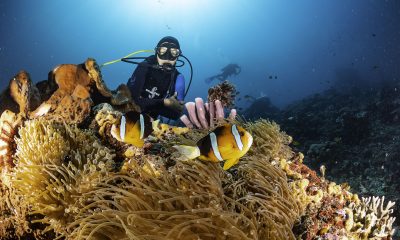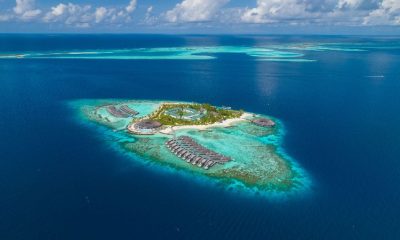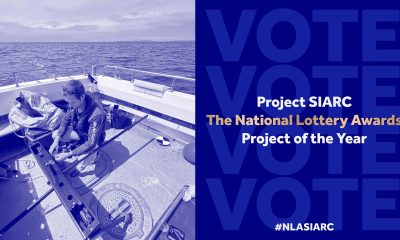News
Giant manta rays found to be predators of the deep ocean
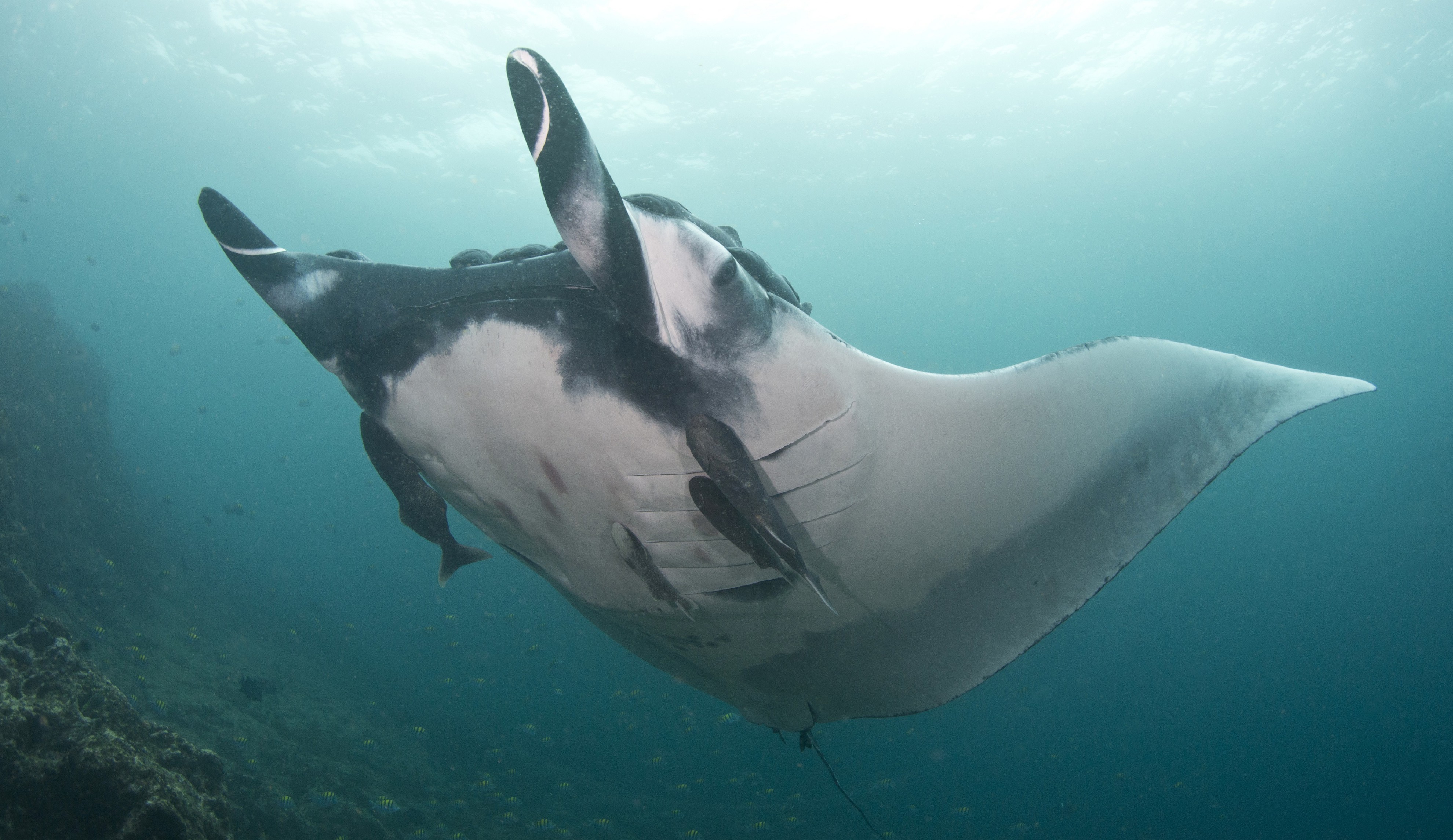
A new scientific study by the Marine Megafauna Foundation (MMF), the University of Queensland (UQ) and Proyecto Mantas Ecuador has been published in Royal Society Open Science today, providing novel insights into the food sources of giant manta rays found in the eastern equatorial Pacific.
The giant manta ray (Manta birostris) is a filter-feeding and highly migratory marine species found in tropical and temperate waters worldwide. The large majority of existing information about the species’ diet is based on observational data limited to feeding activities at the sea surface during daylight at well-known aggregation sites.
This new study focused on Isla de la Plata, an island off Ecuador, which seasonally hosts the largest known aggregation of giant manta rays in the world. Manta ray muscle and surface zooplankton were examined through stable isotope analysis, and revealed that the species’ dietary intake largely comes from the mesopelagic zone (200 to 1,000 meters below the ocean surface) rather than from surface zooplankton as previously thought.
MMF’s manta ray researcher Katherine Burgess, who authored this study as part of her PhD project at the University of Queensland, commented: “Manta rays are one of the most iconic marine animals, yet we still know very little about their feeding habits. The study reports much-needed information on the diet of this elusive species.”
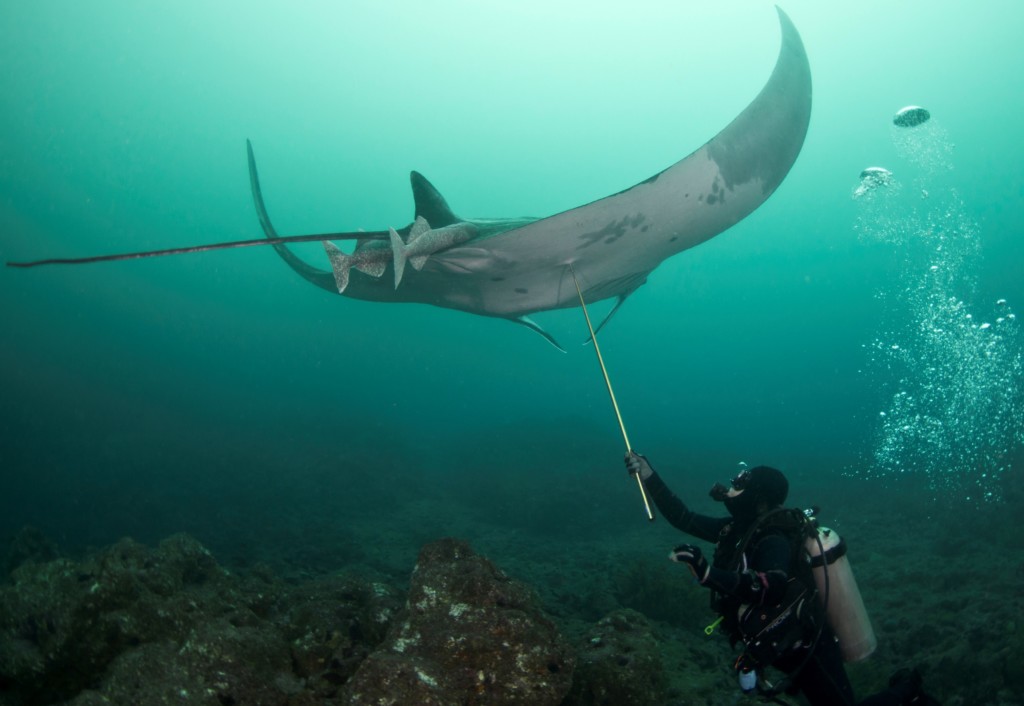
Katherine Burgess taking a tissue sample of a giant manta ray in Ecuador. Copyright: Andrea Marshall
“We studied the giant manta rays’ diet using biochemical tests, such as stable isotope analysis, which work on the ‘you are what you eat’ paradigm. These tests can determine what animals have been eating by examining a piece of tissue from a muscle biopsy from a free-swimming animal,” she added.
Professor Anthony Richardson, a scientist with UQ’s School of Mathematics and Physics and the CSIRO’s Oceans and Atmosphere Flagship, said: “The research found an average 27 per cent of the giant manta rays’ diet comes from surface zooplankton and 73 per cent from mesopelagic sources including fish from 200m to 1,000m below the ocean surface.”
“The deep ocean is the next frontier for open ocean fisheries, and we are only just realizing the potential reliance on this zone by threatened marine megafauna,” he added.
Giant mantas are known to dive to depths of over 1,000 meters making it difficult to study their feeding ecology. To determine the diet of a fish, researchers normally examine its stomach contents. However, this is usually a distressing or lethal procedure and would not be appropriate considering global manta ray populations have been in drastic decline due to anthropogenic threats such as targeted fishing or bycatch, pollution and habitat destruction.
Both species of Manta – the giant manta ray (Manta birostris) and reef manta ray (Manta alfredi) – are listed as ‘vulnerable to extinction’ on the IUCN Red List of Threatened Species. To date, manta rays are formally protected in Ecuador, Peru, New Zealand, the USA (Florida, Hawaii and Flower Garden Banks), Guam, Maldives, Yap, Indonesia, the Philippines and Mexico only. Filling the knowledge gaps on manta ray feeding ecology is crucial for the identification of critical habitats and aggregation sites, which are vital for developing effective conservation measures for these species.
Blogs
Discover Curaçao with the Ultimate Dive Vacation Guide – 2024 DEMA Special Edition

Dive Travel Curaçao is thrilled to announce the launch of the Curaçao Dive Vacation Guide – 2024 DEMA Special Edition, an expertly curated resource that unveils the unparalleled dive experiences and vacation possibilities awaiting you in Curaçao. Produced exclusively for the Diving Equipment & Marketing Association (DEMA) Show 2024, this special edition guide is packed with exclusive insights, travel tips, and limited-time DEMA offers that make it easier than ever to explore Curaçao’s stunning underwater landscapes and vibrant culture.
Explore Curaçao’s Unmatched Diving Opportunities
With over 70 diverse dive sites along its southern coastline, Curaçao is a bucket-list destination for divers of all experience levels. From thriving coral reefs and intricate marine ecosystems to historic shipwrecks, the island offers a variety of underwater experiences that are hard to match. The Curaçao Dive Vacation Guide – 2024 DEMA Special Edition provides detailed recommendations for both shore and boat diving, making it a valuable tool for divers seeking the best entry points, pristine reefs, and hidden treasures along the coastline. Whether you are an avid wreck diver, or a beginner interested in shallow reefs, Curaçao has it all.

Uncover Eco-Friendly Dive Resorts and Top Dive Operators
This DEMA 2024-exclusive Curaçao guide goes beyond diving to feature insider information on Curaçao’s eco-friendly accommodations, dive resorts, and top-rated dive operators committed to sustainable dive tourism. From all-inclusive resorts that support coral reef restoration initiatives to charming boutique hotels near prime dive locations, the guide helps travelers find the ideal stay to match their vacation goals. It also spotlights trusted dive operators on the island who prioritize environmental preservation, offering travelers a way to enjoy the underwater world responsibly.

Immerse Yourself in Curaçao’s Culture, Culinary Delights, and Adventure
Curaçao offers a vibrant Caribbean culture rich in history, music, and culinary fusion. The guide reveals Curaçao’s hidden gems, including culinary hotspots, historical sites, and eco-tourism opportunities that will appeal to both divers and non-divers. Visitors can explore the island’s iconic architecture, savor a diverse range of dishes influenced by Caribbean, European, and South American flavors, and embark on land-based eco-adventures, such as hiking, cave exploration, and visiting national parks.

Exclusive DEMA 2024 Specials and Limited-Time Dive Packages
This special edition guide features limited-time DEMA 2024 offers on dive packages, accommodations, and excursions. Travelers who book through Dive Travel Curaçao, or our Curaçao dive travel partners attending DEMA, will have access to exclusive discounts on custom dive vacation packages, making it easier to plan an affordable, high-quality dive trip that fits your preferences. The Curaçao Dive Vacation Guide – 2024 DEMA Special Edition is designed to simplify your travel planning and help you dive deeper into the incredible experiences that Curaçao has to offer.
It’s Time to Dive Curaçao!
Now is the time to discover why Curaçao is a top dive destination in the Caribbean! Dive Travel Curaçao invites you to experience an unforgettable dive vacation with exclusive DEMA 2024 specials tailored just for you. To secure your spot, download a copy of the Curaçao Dive Vacation Guide – 2024 DEMA Special Edition and contact the Dive Travel Curaçao team to start customizing your Caribbean dive adventure today.
For more information and bookings, please visit Dive Curaçao’s website or contact our reservations team directly.

News
Santa Divers take the Plunge for Charity

Ho Ho Ho! Vobster Quay’s recording-breaking charity Santa diving event returns on Sunday 15th December 2024 for another round of festive fundraising frivolities. Run in aid of the Royal National Lifeboat Institution (RNLI) and Help For Heroes, this ever-popular annual fundraising event aims to raise sack-loads of cash for these two very deserving charities.
Divers of all levels are invited to grab their Santa outfits – and as much festive cheer as they can muster – and head down to Vobster Quay near Mells, Somerset for a mass sponsored Santa dive in aid of charity. In previous years, the event has attracted divers from the far corners of the UK to join in the festive merriment for a final festive dive before the Christmas and New Year break. Back in 2015, the event smashed the world record for the most Santa divers with 188 divers taking to the waters donning their festive finery – a record that remains unbeaten to this day!

Vobster Santas isn’t just about setting records – it’s also about raising some serious cash for charity. Vobster Quay encourages all divers to get into the spirit of the season to raise much-needed funds for two very deserving charities – the Royal National Lifeboat Institution (RNLI) and Help For Heroes.
Through individual sponsorship and online donations, divers can invite their friends, family and work colleagues to sponsor them to plunge into the balmy waters of Vobster Quay dressed in full festive finery. Since the very first Santa dive in 2007, the event has raised over £52,000 for charity. “It’s been over 17 years since the very first charity Santa dive took place at Vobster Quay and every year the event just keeps getting bigger and better” enthused Vobster Quay owner, Amy Stanton.
“Vobster Santas is a great way for divers to say a massive thank you to the both the RNLI and Help For Heroes – two very deserving charities close to our hearts. We’re immensely proud of all that Vobster Santas has achieved and hope that even more divers will join this year’s event on Sunday 15th December. I’m confident that we can make Vobster Santas 2024 the biggest yet!”.
Divers wishing to participate can get involved by simply registering their attendance at
www.vobster.com/event-vobstersantas.php.

-

 News1 month ago
News1 month agoIconic SS United States to become the World’s Largest Artificial Reef
-

 Blogs3 months ago
Blogs3 months agoNovoScuba’s Game-Changing Approach for Dive Store Owners: WE PAY YOU!
-

 News2 months ago
News2 months agoBook Review – 52 Assignments: Underwater Photography
-

 Gear News2 months ago
Gear News2 months agoDYNAMICNORD – New German diving brand enters the British market
-

 News2 months ago
News2 months agoExploring Cenote El Pit: A Diver’s Dream
-

 Gear News2 months ago
Gear News2 months agoTry BARE drysuits (and maybe even win one!) this Friday with Sea & Sea at North West Dive Fest
-

 News3 months ago
News3 months agoComing Soon – 52 Assignments
-

 News3 months ago
News3 months agoSave £200 per person per week at Pole Pole Lodge with Dive Worldwide









